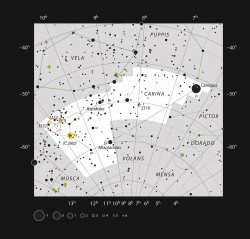The Big Dipper is big. Come on, it’s right there in the name. But how big is the Big Dipper if you could see it from all angles?
Ask someone to name a constellation and they’ll usually say the Big Dipper. Anyone living in the Northern hemisphere who can draw a spoon generally can recognize it in the sky.
I am about to shake the foundations of your reality with a level of pedantry that at bare minimum should earn me a solid shaking and possibly even a face punch or two. The Big Dipper is not, and never will be a constellation.
It’s an asterism, a familiar pattern of stars in the sky. There are 88 constellations, and the Big Dipper isn’t one of them. It’s a part of the constellation of Ursa Major. In fact, the handle of your familiar spoon is actually the tail of the great bear.
Now that I’ve lulled you to sleep with some painfully uninteresting specifics, which you can bust out to make yourself unpopular at your AV Club pop and chip parties whenever someone refers to the “Big D” as a constellation. I strongly suggest whatever it is you tell them, you start off with *ACTUALLY….*
And now that you’ve made it this far, I shall reward you with what you’re seeking. Just how big is that Big Dipper? There are a couple of ways to skin this bear’s tail. We can say its size relative to the amount of sky real estate it occupies, or we can do the end to end Kessel run.

You might be surprised to know how much of the sky it takes up. Astronomers measure the sky in degrees. 360 degrees takes you all the way around the sky, and our Moon measures half a degree across.
Dubhe and Merak are the pointer stars in the Big Dipper. You could put 11 full Moons side to side in the gap between them. And about 40 full Moons from bottom corner of the Dipper to the end of its handle. So, the Big Dipper measures about 20 degrees.
Here are some easy ways to measure sizes. Your pinkie nail, held at arm’s length is half a degree. 3 fingers is 5 degrees, your fist is 10 degrees. Rocking out with devil horns are 15 degrees and hang loose or the inspector gadget phone is 25 degrees.
Trekkers and Trekkies may prefer to use the Vulcan live long and prosper measurement, which is about the same number of degrees you are from getting a romantic companion.

So, stem to stern, how big is our giant celestial ladle? I know you know those things aren’t in anything resembling a straight line. Some of the stars are closer, and some of the stars are further out. If you could make a box that completely surrounded them, how big would it be?
The closest star in the asterism is Megrez at 58 light years. and the most distant is Dubhe at 124 light-years. And yet, they all look roughly the same brightness. This means that Dubhe is a much brighter star than Megrez, and it’s just further away. Because these stars are moving in the sky what we see as a Big Dipper today didn’t always look this way. 150,000 years ago, the Big Dipper looked like this (above).

And in 150,000 years from now it’ll look like this (left). Less dipper, more plow-like. Or maybe a shoe form? Shoes are kind of like ladles, right? Super gross, terribly unhygenic ladles.
Our brains keep from exploding by being pattern making machines. We see collections of stars in the sky and turn them into shapes. But it’s all just a matter of perspective. You’ve got to be right here and now to see the sky we do. Unless you’re looking for a giant “W” in which case you’ll always find one of those. It may not be the constellation Cassiopeia, but it’ll still be a pattern in the stars.
What’s your favorite asterism? Tell us in the comments below.

